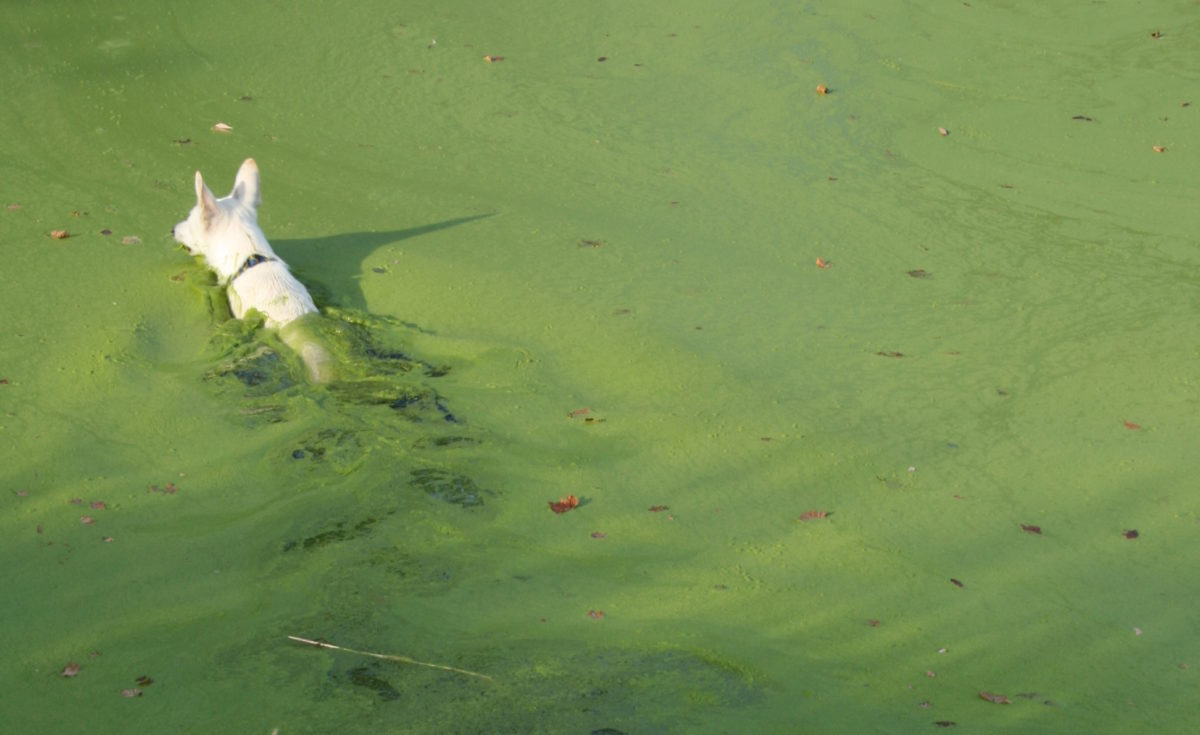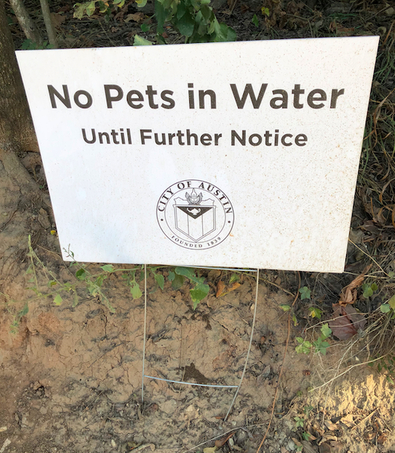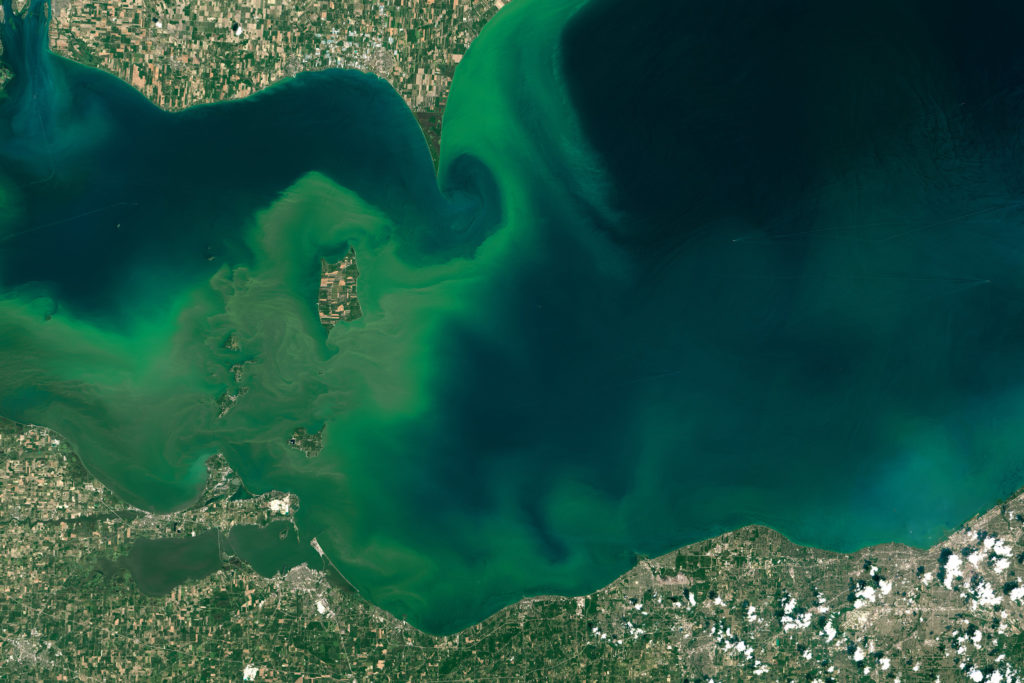
Those fortunate enough to live by a shoreline have inherited a special responsibility along with spectacular views: Your landscaping habits can either help your gorgeous waterway — or harm it.
Summer has become algae outbreak season, with the thick scum coating the surface of lakes, rivers and ponds — and excess lawn fertilizer runoff gets much of the blame for the blue-green algae blooms.

The summer of 2019 has been especially harsh. In addition to causing the usual dead fish, the warm water blooms have taken a toll on dogs. So far in 2019, a total of nine dogs have died after swimming in toxic algae, with five deaths reported in Austin, Texas, alone.
Other dogs have died in Wilmington, N.C., Rochester, Minn., Burlington, Vt. and Bartow County, Ga. Inside the pea-soup blooms lurked toxins that dogs’ smaller livers can’t handle when they chase that ball and then lick themselves dry. They often die within minutes.
There’s no way to tell by looking at the discoloration of a body of water whether the species of algae present in it is a toxic algal bloom or not. According to the Centers for Disease Control (CDC), “A HAB can look like foam, scum, or mats on the surface of water and can be different colors. HABs can produce toxins that have caused a variety of illnesses in people and animals. HABs can occur in warm fresh, marine, or brackish waters with abundant nutrients and are becoming more frequent with climate change.”
Reports of Toxic Algae Blooms Skyrocket
In 2010, there were reports of toxic algae in just three locations across the U.S. Since then, reports of almost 300 harmful algal blooms (HABs) in bodies of water in 48 states have been reported. The problem continues to worsen, according to a report from the nonprofit Environmental Working Group.
Runoff from fertilizer is one of the main causes of HABs. Some algae blooms release cyanobacteria. Some of the bacteria can produce cyanotoxins can harm animal and human health.
Toxic algae are just the beginning. Fertilizer runoff has also been linked to skin rashes, breathing trouble and stomach upset; fish kills; and contaminated drinking water.
If you live on the water, your landscaping practices could either prevent harmful algae blooms — or help cause them.
“The public plays an important role in reducing nutrient pollution,” says the St. Johns River Water Management District, which monitors the water quality of the river as it flows north through 18 Northeast Florida counties. “Each of us can use fertilizers wisely, such as only when lawns show nutrient deficiencies, according to manufacturer directions and avoid using fertilizers just prior to a rain.”
Chemicals in Fertilizer Degrade Water Quality
The nitrogen-phosphorus-potassium fertilizer mix that you apply to lawn has enormous potential to impact water quality:
Nitrogen is water-soluble and can move through the soil and leech into waterways.
Phosphorous, which contributes to vigorous growth, can deplete the oxygen in water and contribute to the formation of algae blooms. One study found that lawn residential lawn fertilizers were one of the dominant sources of water pollution in urban watersheds.
Kevin Frank, an extension turf specialist and professor at Michigan State University, suggests creating a 5-to-10-foot buffer strip between your lawn and the adjacent waterway and avoid applying fertilizer in this zone.
“Maintaining this distance back from the water’s edge helps ensure that when you apply fertilizer, there is reduced risk of throwing fertilizer or having it bounce into the water directly,” he explains.

Tips for Applying Fertilizer
- When choosing fertilizer, opt for organic and slow-release options and apply according to the instructions on the bag. Not only can excess fertilizer leach into the water, Frank notes that it could also burn your lawn. In general, 1 pound of nitrogen per 1,000 square feet of lawn is the recommended application rate. Anything more is just applying excess nutrients, which can run off.
- Apply fertilizer in the fall. A cool-season application helps strengthen the roots, providing a strong foundation for vigorous growth in the spring.
- The United States Environmental Protection Agency also recommends using soaker hoses instead of other methods of watering such as sprinklers, which could lead to overwatering that washes fertilizer into to stormwater system or waterways.
Yes, Fertilize, but Carefully
You need to be careful with fertilizer but you don’t need to abandon it altogether, according to Frank.
“Without fertilizer, the turf may thin over time which results in soil exposure and potential erosion into the water which degrades water quality,” he says.
Golf courses, where the turf is green and the ponds show no signs of green algae, can provide some clues for responsible fertilizer use.
“The biggest difference [between residential and golf course fertilizer application] is simply that golf courses apply relatively small amounts of fertilizer at frequent intervals to control the growth rate,” Frank says. “Also, depending on the design of the golf course and how water comes into play, many golf courses use a buffer strip where there is simply no maintenance conducted. Obviously, this is not always the case, especially on golf courses you see on TV.”
Your Lawn Priority: Good Maintenance Habits
While fertilizer application plays a significant role in maintaining healthy waterways, other landscaping practices also matter.
Yard waste such as lawn clippings and fallen leaves often end up in ditches and storm drains; the debris contains phosphorous. Bag or compost leaves, or leave them on the lawn as natural fertilizer. Mulch your lawn clippings, too. Consistently leaving your grass clippings on the lawn restores enough fertilizer to be able to skip one round of the chemical variety every season.
Frank advises making sure your lawnmower isn’t spitting clippings straight into the lake, adding, “We don’t want to throw clippings directly into water as the clippings contain nutrients that will be released upon decay.”
When you do mow the grass, raise the mower blade. In addition to producing fewer clippings, Frank notes that the extra top growth acts like a solar panel, increasing turf and root growth for a healthier lawn (and healthier water, too).
You should also pick up pet waste. Phosphorus-rich poo is the second biggest contributor to waterway pollution. Toss it in the trash or flush it down the toilet.
With a little extra attention, you can have a beautiful lawn and protect the waterways that surround you. In fact, Frank says, “Growing a dense, healthy lawn near the water can help preserve water quality by preventing soil erosion into the water.
Image of German shepherd swimming in algae by Ildar Sagdejev. CC BY-SA 4.0